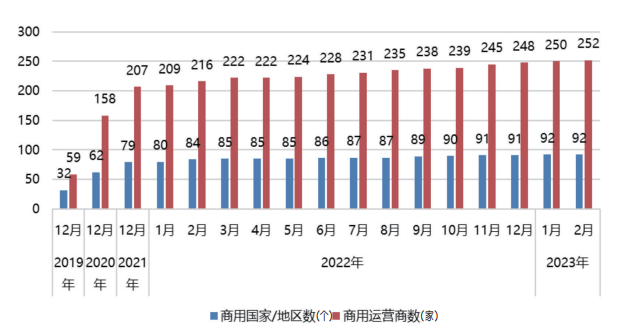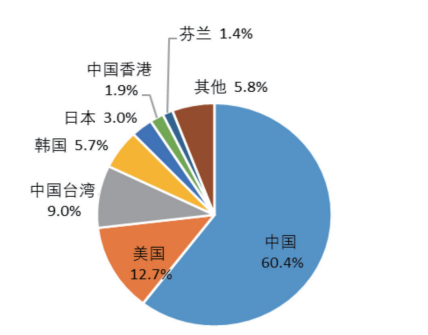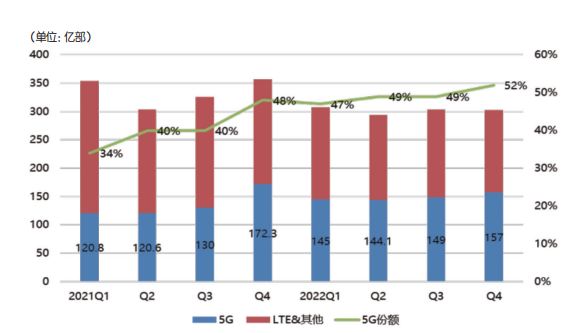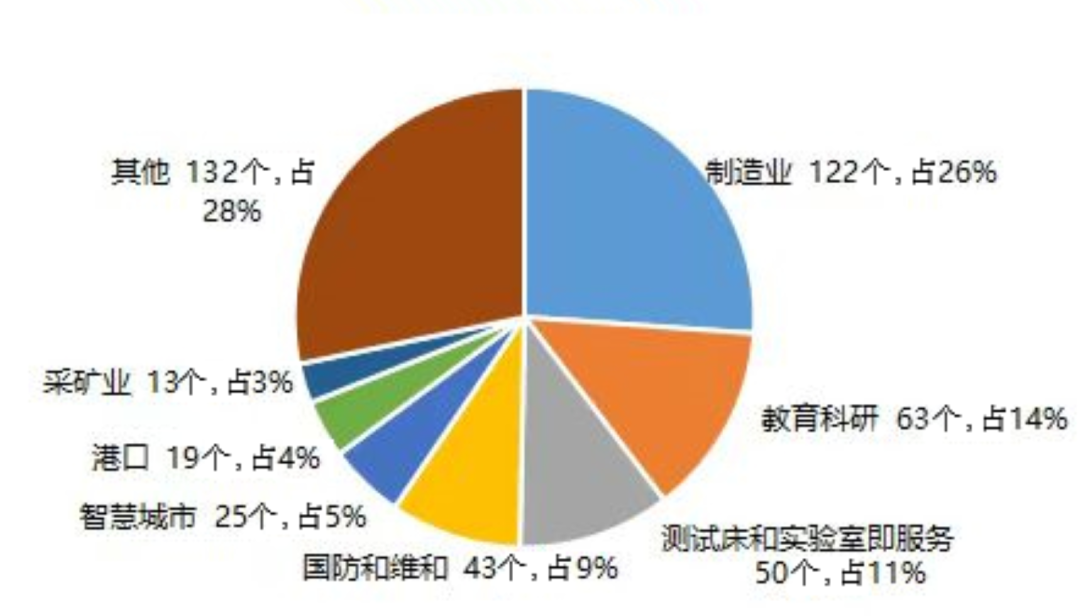The latest developments and future prospects of the global 5G market

The latest developments and future prospects of the global 5G market
From smart medical care to the Internet of Everything, from unmanned driving to the "new infrastructure" related to my country's future development, since the global 5G commercial launch in 2019, 5G has entered the "fast lane" of development; will continue to maintain rapid and stable growth The development momentum is strong in network construction, population coverage, terminal form, etc., and significant progress has been made in technical standards, industrial innovation, and integrated applications.
overall development
The scope of commercial use continues to expand. It has been four years since the world officially entered the 5G era. More than 200 operators in more than 90 countries and regions have announced the provision of 5G services (including fixed wireless and mobile services), and the scope of commercial use has continued to expand from mainstream developed areas to underdeveloped areas. Europe, Asia-Pacific, and North America are the first regions for 5G network construction, and major countries and regions have basically realized commercial use ;South Asia, Eastern Europe, Central and South America, Africa and other regions have successfully carried out 5G network deployment and pre-commercial use. The global 5G commercial situation is shown in Figure 1.

Figure 1 Global 5G commercial use from 2019 to 2023
Steady progress was made in infrastructure construction. In 2022, the global 5G infrastructure market will be close to US$30 billion, with a cumulative total of over US$90 billion. In 2022, the global 5G base station shipments will exceed 1.4 million, a year -on-year increase of 20%, and the cumulative shipments will exceed 3.8 million. My country has alway to the. In 2022, 887,000 New Base Stations Will Be Built, and a Total of more than 2.31 million 5G base stations will be opened, accounting for 60% of the global total.
The number of 5G mobile users exceeds 1 billion. By the end of 2022, the global 5G mobile users have exceeded 1 billion, accounting for 12.1% of the total mobile users, and the network covers nearly 30% of the world's population. my country has built the world's largest 5G network and independent networking network. The number of 5G users has reached 560 million, accounting for more than half of the total number of users in the world. The penetration rate is 33.3%, which is only lower than that of South Korea and the United States.
5G drives mobile traffic growth. The "Ericsson Mobile Market Report" shows that the average monthly total global mobile data traffic will be 90EB in 2022, an increase of 32.4% compared to 2021. 5G mobile traffic reached 15EB/month, doubling compared to 2021 , accounting for 17% of the total mobile traffic, an increase of 7 percentage points compared to 2021. Taking South Korea as an example, as one of the first countries in the world to realize 5G commercial use, in January 2023, the DOU of 5G users in South Korea reached 26.8GB/household, which is 3.6 times that of 4G users.
5G industry development
Standard patents and key technological innovations
At present, R17, the second evolution version of 5G, has been officially completed. In mid-2022, 3GPP announced that the 5G R17 standard will be frozen, focusing on supporting medium and high-speed large connections and differentiated IoT application ations, further expanding 5G application scenarios and solutions. Release 17 allows more 5G system enhancements to gradually mature, extending 5G to new terminals, applications, and commercial deployment areas. According to the follow-up work plan of 3GPP, the R18 version will be frozen at the end of 2023, or commercial deployment will begin in 2024.
my country leads the way in the number of 5G patents. According to data from the German patent company IPLytics, as of the end of April 2022, there are 50,415 5G application patent families (including pending and granted) worldwide. Among the patents submit ted to the US and the European Patent Office, China (26.79%), South Korea (25.94%), the United States (17.75%), the European Union (15.59%), and Japan (8.52%) ranked the top five. In terms of core standard essential patents, the European Union (37.04%), China (33.96%), and the United States (15.89%) made major contributions.
5G chip technology innovation is accelerating. Manufacturers such as Qualcomm, MediaTek, Ziguang Zhanrui, and HiSilicon have released 93 5G chips. Recently, at the 2023 Mobile World Congress, Qualcomm announced that it will launch the world's fir st "5G Advanced-ready" baseband product, namely the 5.5G Snapdragon X75 chip, which supports ten-carrier aggregation and can be realized in Wi-Fi 7 and 5G. 10Gbit/s downlink speed, commercial terminals are expected to be released in the second half of 2023. While demon stratifying the new 5G call chip solution, Ziguang Zhanrui also deployed industrial electronics businesses such as automobiles, and demonstrated the first car-grade 5G smart cockpit chip platform A7870 on site.
Network equipment
The ecological boundary of the equipment market continues to expand. The base station equipment market is mainly occupied by traditional equipment manufacturers such as Huawei, Ericsson, Nokia, ZTE, and Samsung. Operators hope to realize open and interoperable network solutions thr ough the virtualization of radio access networks, so as to get rid of the dependence on the existing single equipment vendors; network software suppliers such as Mavenir and Parallel Wireless join the competition in the equipment market. In addition, emerging 5G equipment suppliers are gradually increasing, and there are more than 50 manufacturers worldwide providing equipment for 5G private networks.
But the deployment of Open RAN has not yet taken shape. The European Union is cautious about Open RAN. The "Open RAN Network Security Report" released in May 2022 pointed out that Open RAN is not mature enough and will increase some security risks in the short term. It is recommended to adopt a cautious approach to this architecture. Pioneering operators such as Rakuten Mobile in Japan, Dish in the United States, and 1&1 in Germany have not made progress in Open RAN as expected. The cost of network deployment has soared, and the user market has been sluggish. Although Open RAN has not yet been deployed on a large scale, its growth momentum should not be underestimated. Recently, manufacturers such as NTT Docomo, Deutsche Telekom, and Vodafone are actively promoting their commercial deployment plans. Omdia data shows that Open vRAN will increase by 300% in 2021, and will also grow strongly in 2022. It is expected to account for about 16% of the entire market by 2026.
5G terminal development
The form of 5G terminals is becoming more and more abundant. According to GSA data, as of February 2023, a total of 224 equipment suppliers around the world have released 1,840 5G terminals, nearly 80% of which have been commercially launched; among them, A total of 948 mobile phones have been released, at least 874 of which have been commercially available, with prices below 1,000 yuan. Further lay the industrial foundation for the popularity of 5G terminals. The types of terminals continue to expand and enrich. In addition to mobile phones, modules, and CPEs, the industrial gateway ecosystem is becoming more and more mature. Mobile robots, drones, and XR devices can be connected to the gateway through modules. With the acceleration of 5G innovation, related products will also expand in the future. Accelerated rollout. From the perspective of brand affiliation, my country has significant advantages in the field of terminals, and over 60% of 5G terminals are domestic brands. The pro ducts of China, the United States, South Korea, Japan and China Taiwan account for more than 90% of the total market, and the 5G terminal market is highly concentrated. The specific situation is shown in Figure 2.

Figure 2 Market share of 5G terminal products by country/region
5G smartphone shipments accounted for more than half for the first time. In 2022, the total global smartphone shipments will reach 1.21 billion units, of which 595 million 5G smartphones will be shipped, a year-on-year increase of 9.4%, ac counting for 49.1% of smartphone shipments. In the fourth quarter of 2022, affected by Apple's shipments, the penetration rate of global 5G smartphone shipments will exceed 50% for the first time. In terms of brands, Samsung ranked first with a market share of 21.4% , an increase of 0.9 percentage points year-on-year; Apple, Xiaomi, OPPO, and vivo ranked 2 to 5, with shares of 19%, 13%, 9% and 8% respectively . Affected by the proportion of Apple's 5G smartphones , the average price of global 5G smartphones in 2022 will still be higher than $600. The average price of an Android 5G smartphone is slowly falling, with the average price dropping below $400 for the first time in Q4 2022, reaching $378. Figure 3 shows the global 5G mobile phone shipments in 2021-2022.

Figure 3 Global 5G mobile phone shipments from 2021 to 2022
Industry application
Countries are actively promoting the implementation of 5G applications. According to incomplete statistics from the China Academy of Information and Communications Technology, among the 644 industrial application trials or deployments that have been carried out globally, the industrial Internet and culture al and sports activities account for more than half, and the industrial applications in the fields of smart transportation and medical health are more extensive. . The United States attaches great importance to the leadership of 5G technology. All parties in the industry cooperate to test and develop 5G industrial use cases, and explore the path for 5G to promote the growth of industrial manufacturing. South Korea fully promotes 5G integrated applications to the industry, actively supports technology upgrades, activates the industrial ecology, and supports the global expansion of 5G integrated applications. Through policy release and project deployment, the EU has est ablished a clear path for the integration and application of 5G and vertical industries, and carried out extensive 5G industry application trials in seven key industries and multiple vertical fields such as ports, agriculture, and transportation. At present, 5G industry applications in major countries are mostly in their infancy .Although there are many demonstration projects, there are relatively few mature applications that can be replicated on a large scale. my country has entered a critical period for the large-scale application of 5G, with a total of more than 50,000 5G application cases, and innovations have been integrated into more than half of the national economy. According to the forecast of China Academy of Information and Communications Technology, in 2022, 5G will directly drive the total economic output of 1.45 trillion yuan, and directly drive the economic added value of about 392.9 billion yuan.
5G private network applications are in the exploratory stage. Since 2018, the number of private networks using 5G technology has continued to grow. By the end of 2022, the number of 5G private networks in the world will reach 467, of which 181 will be added in 2022. 5G private network covers manufacturing, mining, ports, logistics, healthcare, public utilities and other industries. Although it is growing rapidly, it is still in the period of extensive exploration. From the application point of view, service case s such as test beds and laboratories accounted for 11%, providing experimental infrastructure for testing and verifying the performance of 5G private network equipment and accelerating technology maturity. The manufacturing industry is the most active 5G private network application industry, with application cases accounting for 26% (122), of which 96 are discrete manufacturing application cases. As shown in Figure 4.

Figure 4 Industry distribution of 5G private network applications
Prospects for 5G Industry Development in 2023
The new generation of information and communication technology represented by 5G and 6G is not only the basis for realizing the Internet of Everything, but also an important driving force for economic and social transformation and upgrading. 5G will be commercially available for four years, and 6G has entered the stage of strategic layout, becoming a new focus of competition among major powers. Looking forward to 2023, the following development trends will be presented.
The 5G market continues to maintain a strong momentum of development. First, 5G network coverage is wider and deeper. 5G commercialization continues to be fully rolled out and promoted to emerging markets, and 5G NSA continues to evolve into 5G SA. , the number of 5G users continues to grow. It is estimated that in 2023, the number of 5G mobile users will reach 1.5 billion, accounting for 17% of the number of mobile users; it is estimated that the number of 5G mobile users will reach 4.2 billion In 2028, accounting for more than 40% of the global mobile users. The third is the further growth of mobile data traffic. It is estimated that in 2023, the global 5G mobile data traffic will exceed 31EB/month, accounting for 26.8% of all mobile data traffic; it is expected that this proportion will increase to 69 % by 2028, when mobile data traffic All growth will come from 5G.
5G applications accelerate the empowerment of thousands of industries. First, the application gradually penetrates into the core links of key areas. In the field of industrial Internet, twenty typical application scenarios such as remote control of equipment, machine vision quality in Spectrum, and production energy efficiency control have been formed. In the medical field, solutions such as "5G+emergency vehicle", "5G+remote consultation" and "5G+remote postoperative rehabilitation" have been deployed. The second is to promote the development of industry terminals. The number of 5G device models and chipsets will continue to grow, and the supported functions will also continue to increase. The 5G industry's customized terminals will develop in the direction of diversification, customization, and scale. The third is to strengthen the integr ration of industrial innovation. The empowerment of 5G to the industry will gradually move towards the stage of substitution optimization and original transformation, driving the digital economy to create a new growth curve.
Countries focus on 6G strategic layout. The United States, South Korea, and Europe are actively launching early 6G R&D work, planning the deployment of next-generation networks in advance from top-level design to strategic cooperation. South Korea even advanced its 6G commercial plan to 2028. Looking forward to the future, first, the direction of 6G technology is gradually becoming clear. The ITU working group plans to formulate a 6G "Future Technology Vision Proposal" before June 2023, and use this as a basis to formulate detailed technical specifications. The selection of 6G technology has entered the window period. The concept and vision are gradually clear, and the key technical directions are gradually converged. The second is that major countries in the world are accelerating their occupation of the "6G track". In the future, the competition for the right to speak in international standard-setting institutions will become increasingly fierce, and the competition for the right to speak in international 6G standards will become "white-hot." The third is that the development of 6G technology has created a broad market space. In 6G applications, new businesses and new services such as intelligent body interaction, communication perception, and inclusive intelligence will emerge, bringing 6G a broad market space with hundreds of billions of terminal connections and a trillion GB of monthly average traffic.